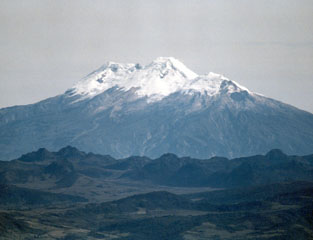Report on Nevado del Huila (Colombia) — 12 November-18 November 2008
Smithsonian Institution / US Geological Survey
Weekly Volcanic Activity Report, 12 November-18 November 2008
Managing Editor: Sally Sennert.
Please cite this report as:
Global Volcanism Program, 2008. Report on Nevado del Huila (Colombia) (Sennert, S, ed.). Weekly Volcanic Activity Report, 12 November-18 November 2008. Smithsonian Institution and US Geological Survey.
Nevado del Huila
Colombia
2.93°N, 76.03°W; summit elev. 5364 m
All times are local (unless otherwise noted)
The Washington VAAC reported that on 11 November occasional emissions of gas and possible ash from Nevado del Huila were observed on satellite imagery. During 12-18 November, INGEOMINAS continued to receive reports of strong sulfur odors and ashfall in areas to the W and SW. They also noted that 14 instances of ash emissions were detected on satellite imagery during 13-14 November. Sulfur dioxide plumes were also detected on satellite imagery. According to the Washington VAAC, a pilot observed an ash plume on 14 November that rose to an altitude of 6.1 km (20,000 ft) a.s.l. and drifted SW. News articles stated that classes at educational institutions near the Páez and Símbola rivers were suspended while the Alert Level remained at Orange.
Geological Summary. Nevado del Huila, the highest peak in the Colombian Andes, is an elongated N-S-trending volcanic chain mantled by a glacier icecap. The andesitic-dacitic volcano was constructed within a 10-km-wide caldera. Volcanism at Nevado del Huila has produced six volcanic cones whose ages in general migrated from south to north. The high point of the complex is Pico Central. Two glacier-free lava domes lie at the southern end of the volcanic complex. The first historical activity was an explosive eruption in the mid-16th century. Long-term, persistent steam columns had risen from Pico Central prior to the next eruption in 2007, when explosive activity was accompanied by damaging mudflows.
Sources: El Liberal, Washington Volcanic Ash Advisory Center (VAAC), Servicio Geológico Colombiano (SGC)

